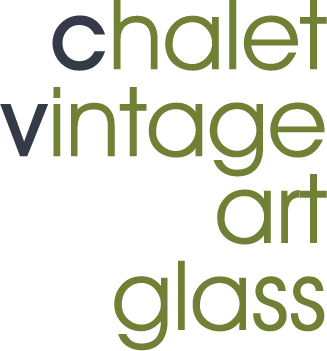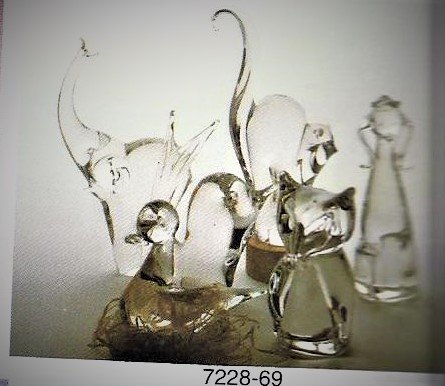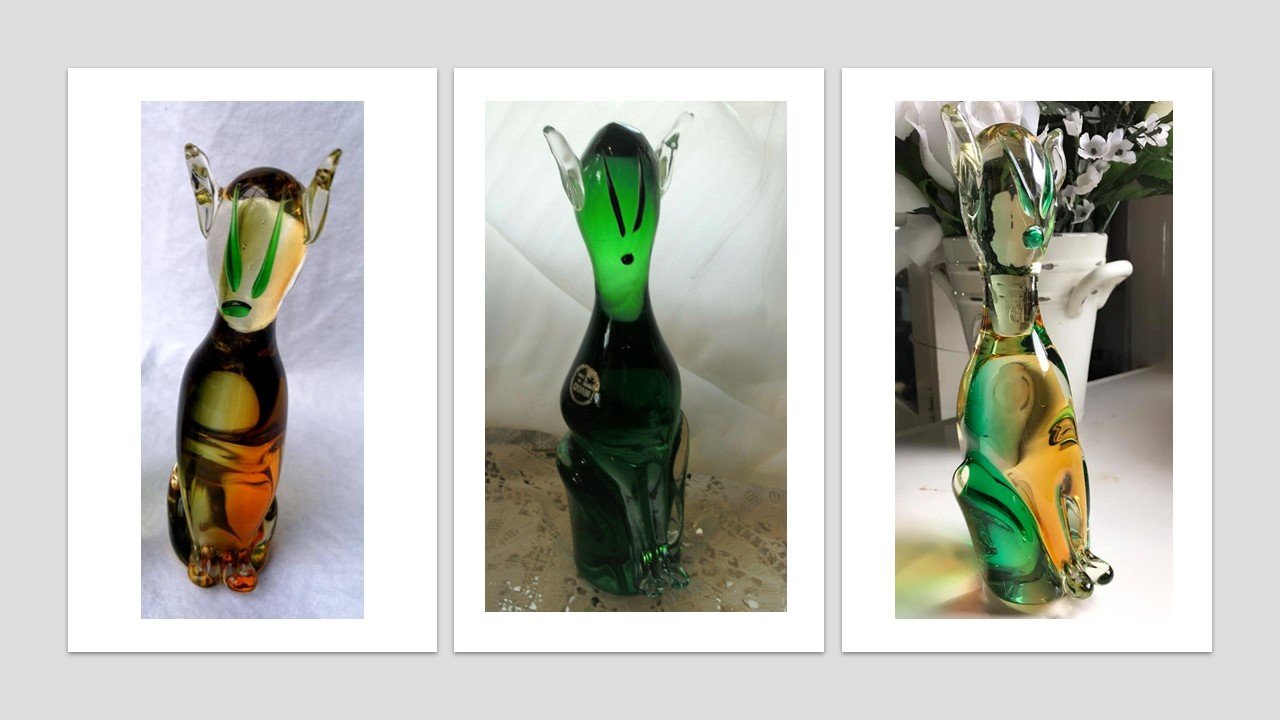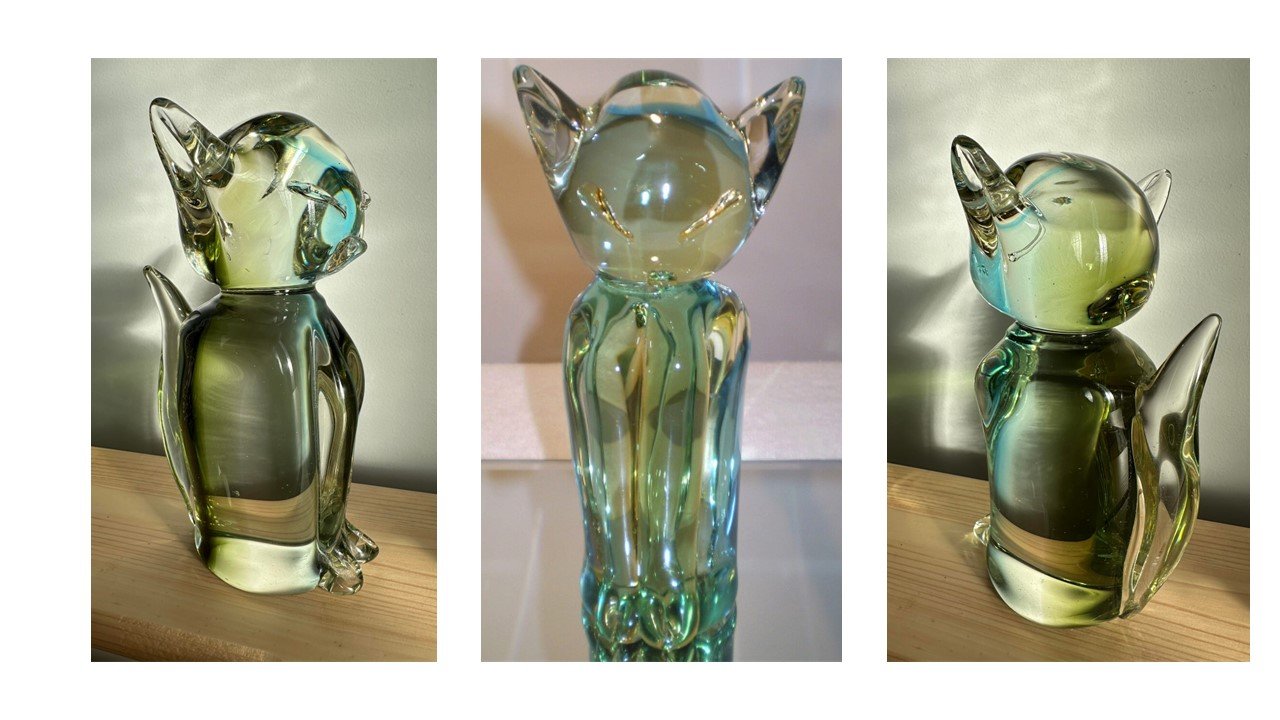Chalet Cat Figurines
March 28th is “National Respect your Cat Day.” Why?
It’s unclear who first declared March 28th a day for respecting cats, and there aren’t any online mentions of it predating 2014. However, some sources claim this special day has a centuries-old connection to March 28, 1384 when King Richard II of England passed an official edict banning the consumption of cats. Some cat “back story” before we look at the Chalet cat:
Humans domesticated cats in the Middle East 10,000 – 12,000 years ago. Cats were revered in many of the region's traditions with the most famously recorded being their elevation to “ Gods” by the Ancient Egyptians 4,000 years ago. They worshipped the cat goddess, Bastet and felines were kept in temples and homes as sacred creatures. Roman soldiers brought cats with them to new territories as a means of pest control. Cats were valued in early Asian civilizations as defenders of rice stores and for keeping temples and ships free of rodents. In ancient China, farmers worshipped the cat goddess Li Shou, a fertility goddess.
However, in Europe, by the Middle Ages, cats were demonized to the point where they were systematically killed. The cat lost its former position through the efforts of the medieval Church which encouraged the association of the cat with devils and darkness as part of their long-standing agenda of demonizing pagan faiths, rituals, and values. Religious bigots have often employed the cunning device of converting other people's heroes into villains to suit their own purposes. By doing this, the revered and sacred feline of ancient Egypt became the wicked sorcerer's cat of medieval Europe. Many things considered holy by a previous religious faith have automatically been damned by a new religion. Hence the darkest chapter in the cat's long association with humans - for centuries it was persecuted and these cruelties were given the full backing of the Church. The inhabitants of the European nations, believing the cat to be evil, shunned and punished not only cats but anyone who seemed overly fond of them.
Once the cat was associated with Satan, it was regularly tortured and killed either to ward off bad luck, as a sign of devotion to Christ, or an integral part of rituals involving ailuromancy (using cats to predict the future). Cats were condemned by popes and massacred by entire villages and did not regain even half their former status until the Age of Enlightenment in the 18th century. The Victorian Age of the 19th century saw the cat's full restoration in status.
Fast forwarding to the 20th Century, cats were used in the trenches of WWI to weed out pests and detect poison gas. Today, the farm “barn cat” has not disappeared. Currently most cats are kept for companionship. While this may not seem as elevated as the roles they had in the past, the reality is that pet companionship is ever more crucial as working remotely from home and spending less time with others in general has increased. Go cats!
I thought it would be fun to respect the “Felis Catus” through a Chalet article. Hopefully, it will trigger you into buying some catnip or a new toy to honour your special fur baby. And if you have a little human as well, snuggle up together and read some old standards such as “The Cat in the Hat”, T. S. Eliot’s “Macavity” and “The Naming of Cats”, the “Owl and the Pussycat” or put on “The Aristocats” and sing-along.
There are three different styles of Chalet cat. The most common is the four paws on the ground “Halloween cat” with arched back pose. Lesser seen is the upright “sitting on haunches with feet together” pose. The third style, the “curled-up cat”, appears to be limited to the avventurina cats.
None are featured on any of the Chalet inventory sheets that we have seen. Like some other Chalet forms, the cats were produced in opaline, avventurina, and avventurina and bullicante. Unlike other animal figurines like the goose, chick, elephants, and polar bears, we have not come across any cat figurines which contain uranium.
The three styles of Chalet cat figurines.
The Chalet “Halloween” cat pose figurine was done in 2-tones, clear crystal and a rose coloured solid. No black cats though!
The 2-tone colour palette was blue/yellow, green/yellow, blue/emerald-green and blue/olive green. The most commonly seen is the blue/emerald-green. The least, blue/yellow figurines. To date, unlike other Chalet animal figurines such as the owls or elephants, we have not found rarer colours in 2-tone combinations.
The 2-tone colour palette of the Chalet cat. Cats one to three from left from the clowder of Melissa Patterson. Photograph at far right of blue/olive cat figurine courtesy of 50 Shades member Cindy Bishop Loughlin.
As with all Chalet forms, there is variation from piece to piece. Commonly seen, different tones of the same colour as well as differing colour placement is the norm.
These four cats show significant differences from feline to feline. Although only two 2-tone colour combinations are shown here, note the differences in each within that context. They also demonstrate variation in colour placement. There is no uniformity or standard. Another obvious difference is in the arch of the back arch. Tail shape and tail position is more consistent. Photograph on the left courtesy of 50 Shades member Michael Flink.
Directly above, are two blue/olive green cat figurines. In these two, head colour is olive. Here is a third cat (at right in photo) in the same blue/olive green colour combination. However, note that the head colour is not olive. And that colour in the tail goes much higher. Another example of variation as the norm.
The following pair perfectly illustrates several more variations. Obviously, they are differently coloured 2-tones but this notwithstanding, they perfectly illustrate the range in height that is common to these figurines. They also are a good example of the common differences in how the tail can be placed and posed.
The very rare solidy coloured “rose” cat:
This exceedingly rare Chalet cat purrs for Melissa Patterson.
Chalet used distributors Chantili and N. C. Cameron to distribute the clear crystal cats on Canada and Riekes Crisa in the United States. Both the Riekes Crisa catalogs that I have show the cat figurines. In the 1976 catalogue, the arched back and sitting upright poses are offered:
The later undated catalogue shows only the Chalet “Halloween” cat as available.
And I have been fortunate to have one retaining not only its original Riekes label but its original retail store sticker and found the retail store advertising the cat!
And I have been fortunate to have one retaining not only its original Riekes label but its original retail store sticker and found the retail store advertising the cat!
These are two distinct sizes of the clear crystal cat figurine. Mama cat and kitten cat:
From the collection of Melissa Patterson
The second style, the upright sitting on haunches pose, does not appear to have been done in 2-tone combinations as was the Lorraine cat figurine of similar pose. It is most commonly seen in clear crystal. This style has been found with the Chalet etching, the Chantili and N. C. Cameron stickers and as seen above, it is shown in the 1976 Riekes Crisa catalog. Here it is with best pal “Poodle Boy.”
Both figurines retain their original Chantili stickers. From the collection of Deborah Patterson.
This style was not only done in clear crystal. It was also done in multi-coloured opaline. To produce the opaline animal figurines and larger pieces, lead arsenate was added to the clear crystal molten glass mixture in the vat to create a milky, white appearance. The clear glass loses its transparency and becomes opaque. Opaline glass was used not only in two complete and distinctive hand molded Chalet lines but also to create some very memorable stand-alone animal figurines. As well as opaline felines, we have also seen opaline polar bears, elephants, and roosters.
50 Shades member Troy Danby is very fortunate to have this exceptionally rare piece in his collection.
Like many of the rarer Chalet animal figurines, the upright cats were also produced with silver and gold metal inclusions. In Chalet silver foil and gold leaf animal figurines, small ultra-thin sheets of these metals were used. These silver or gold sheets were made by the precious metals having been beaten into an extremely thin leaf-like state of about 0.15 micron in width. To give you an idea of such a thin surface, this reflects about 20 grams of the precious metal covering six square meters. The sheets were then cut into small squares of about 8 cm. To infuse this gold or silver into the form, the Maestro started by rolling these small 24K gold or .925 silver sheets onto the hot glass mass during the early stage of glass-blowing. Once the gold leaf or silver foil covered most of the gather, he added a layer of clear crystal. Then, when he began to blow the glass, the metal sheet within the layers broke into smaller pieces which dispersed throughout the piece. This resulted into objects having scattered metallic pieces if differing sizes and shapes captured inside the form producing shimmering effects. These may appear close to the surface or submerged within deeper layers of clear crystal. There is no uniformity from piece to piece.
Troy Danby’s luck with his collection definitely has “nine lives.”
Both gold filled avventurina and gold avventurina bullicante cat figurines in the third style, the curled-up pose, have been found. Like the owl figurines, the most common colour with the gold dust fill is blue. There is one gold gold avventurina and bullicante figurine on file. However, to date, unlike the polar bears and owls, no green cat figurines have been discovered.
Avventurina only:
Placement and intensity of the gold dust/flakes varies from piece to piece resulting in very distinctive patterns. Shades of blue and colour placement are also diverse. Typical marking is the Chalet etched signature. Cat figurine on right from the collection of 50 Shades member Jonathon Tremblay.
Avventurina and bullicante:
The gold gold avventurina and bullicante figurines referred to above. These are the only figurines like this that we know of at present.
Shades of blue are the norm.
We also have seen avventurina and bullicante in the Chalet “Buddhas belly” owls. This stunning pair from the collection of the Zhao family.
Chalet cat figurines have been found with a variety of markings. The 2-tones and solid coloured are typically etched with the “Chalet Canada” signature. The upright clear crystal has been found both with a Chantili sticker and a N.C. Cameron and Sons Ltd. label. The arced back clear crystal is usually stickered with the black palette-shaped Chalet Riekes Crisa hallmark. The avventurina and the avventurina and bullicante are typically etched ‘Chalet Canada” but may also retain the rarely seen Chalet “Boutique Collection” hang tag
This is the only Riekes sticker that we have found on the cat figurine as of yet.
The clear crystal upright figurine has been found with 2 different stickers – the Chantili label and the N. C. Cameron label. If you look very closely you will see that the stickered base at right also is etched “Chalet Canada.”
This figurine retains its original “Boutique Collection” hang tag as well as bearing a “Chalet Canada” signature.
Lorraine Glass Industries, EDAG, Rossi Glass, and Altaglass also produced cat figurines. To date, we have found no cat pieces made by Mosaic Artistic Glass.
Lorraine cats were made in 2 different styles. A “four paws on the ground” pose and the upright sitting on haunches pose.
From the collection of 50 Shades animal lover and champion Jo Highland. This is a very rare piece.
There is a great deal of variation in the two styles of upright Lorraine cat. Both in colour and form.
The upright Lorraine cat was done in different stylings.
The slender upright cats were produced in solids and different 2-tone colour combinations. Cat on left from the collection of 50 Shaders Josh Dolstra while cat on right from the collection of Amy Thrifty.
This photograph, once again courtesy of 50 Shades member Michael Flink, is perfect for showing the colour placement.
The thicker styled upright cat was done in various 2-tone combinations as typically found in other Lorraine Glass animal figurines.
Two differently coloured cats. Cat figurine in middle is an amber/blue 2-tone while cat at outer left and right, from the collection of 50 Shades member Kay Bee, is in an olive/blue colour combination.
EDAG cat figurines were also made in 2 different styles. Once again, a “four paws on the ground” pose and the upright sitting on haunches pose. Very odd little figurines that could pass for a rabbit or fox . They are exceptionally rare. However, I can not provide a photograph of either as I was denied permission to use the images publicly here.
Rossi Glass produced only one style of cat figurine. And, to date, I have found in only blue.
There does not seem to be much variation in the styling of Altaglass cats as well. However, the colour variety is extensive. A few:
A vintage Murano cat figurine by Carlo Moretti:
Uprights all together now!
Upper left Rossi Glass, middle Chalet, upper right Altaglass, lower left Murano and lower right Lorraine.
Swedish glasshouse F.M. Ronneby did a lovely clear crystal “Halloween” cat:
A side-by-side comparison with its Chalet counterpart:
Ronneby at left and Chalet on right.
Something to think about as we end, you can also “respect your cat” in a broader sense by making a monetary donation, dropping off some food or supplies or giving your time at your local animal shelter, pet rescue sanctuary or feral cat organization.


































